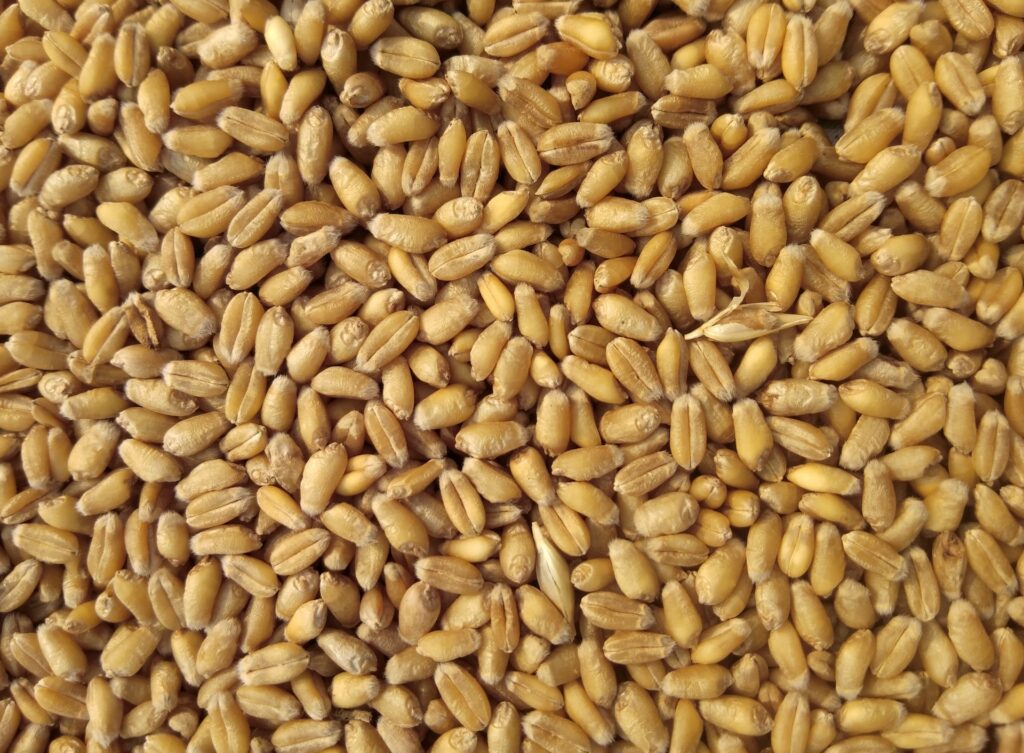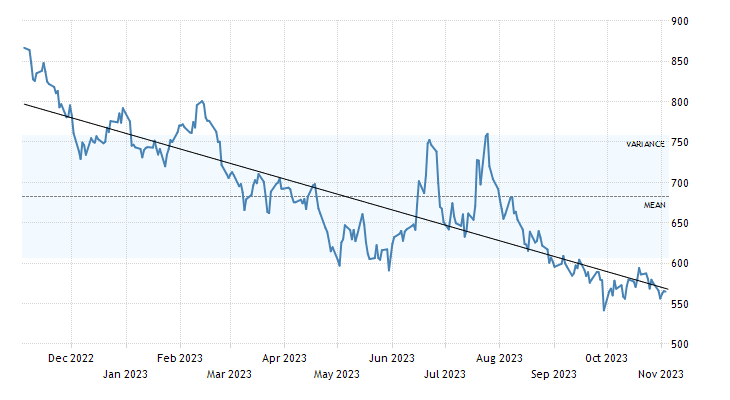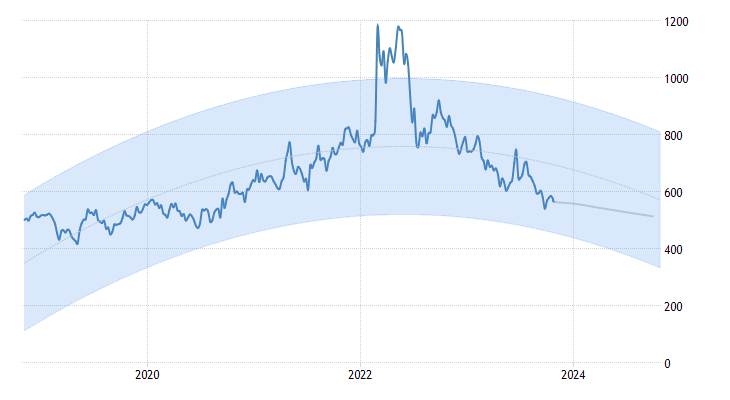Introduction
In the ever-evolving world of commodity trading, Wheat futures have been under the spotlight, as they plummeted to $5.6 per bushel in the US. This decline marked a stark retreat from the one-month high of $5.9 reached on October 19th. The driving force behind this drop is the resurgence of expectations surrounding the robust supply of wheat. Recent ship tracking data has revealed a new trade corridor emerging from the Black Sea, with vessels carrying Ukrainian grain departing from ports in Odesa. This development has ignited hopes that Ukraine will be able to offload some of its stored grains from the latest harvest.
Furthermore, the global wheat market finds itself grappling with an abundance of grain, thanks to bountiful harvests in Australia and Argentina. These generous yields have only added to the mounting supply, causing quite the stir in wheat trading circles.
As we take a closer look at the year-to-date performance of wheat benchmarks, a notable trend emerges – a substantial decline. What’s driving this downward spiral? Well, it can be traced back to Russia, where their export expectations have shot through the roof. This surge in Russian exports has cranked up the heat on the global selling competition.
Just recently, the United States Department of Agriculture (USDA) dropped a bombshell in its World Agricultural Supply and Demand Estimates (WASDE) report. Brace yourselves, because the numbers are jaw-dropping. The projection for the 2023/34 marketing year in the US is a mind-boggling 85 million tonnes of wheat. But that’s not all. The report also forecasts exports for the same period to skyrocket to an astonishing 50 million tonnes. This bold prediction solidifies the United States as the undisputed heavyweight champion of global wheat exports.
The dynamic nature of the Wheat futures market often leaves traders and investors navigating uncertain waters. As the $5.6 per bushel mark becomes a focal point for market participants, it’s crucial to dissect the various factors contributing to the current state of affairs.

The dip
First and foremost, the recent dip in Wheat futures can be attributed to the renewed optimism regarding the supply side of the equation. Ship tracking data has offered a glimpse into the potential transformation of the Black Sea region into a bustling trade corridor for wheat. The departure of vessels laden with Ukrainian grain from Odesa’s ports signifies a newfound route for wheat exports. While this development is welcome news for Ukraine, it also signifies a potential influx of wheat into the international market, which could exert further downward pressure on prices.
Global Supply
Australia and Argentina have also played their part in increasing global wheat supply. Both countries have witnessed exceptional harvests, adding to the already abundant stockpile. Such surpluses invariably lead to greater competition among exporters vying for a piece of the international market share. In this context, Russia’s ambitious export goals have been particularly influential in driving global wheat prices down. With a record 50 million tonnes of wheat slated for export from the United States in the 2023/34 marketing year, it’s evident that the battle for market dominance is more intense than ever.
Transitioning from a global perspective to the specifics of the US market, the recent dip in wheat futures has raised questions about the impact on domestic stakeholders. Wheat farmers and agribusinesses are undoubtedly feeling the effects of the changing landscape. A crucial aspect to consider is the potential consequences for US exports and the domestic wheat market.
As Wheat futures hover around the $5.6 per bushel mark, US producers are left to ponder their strategies in a highly competitive environment. The increased supply on the global market, driven in part by Ukraine’s newfound trade corridor and bountiful harvests in Australia and Argentina, means that US exporters will face stiffer competition. The record-breaking export estimate of 50 million tonnes set by the USDA for the 2023/34 marketing year is a testament to the immense challenge confronting American wheat producers.

In the grand scheme of things, the global wheat market’s dynamics hold immense significance for the United States. While the nation stands on the cusp of becoming the planet’s foremost wheat exporter, it can’t afford to rest on its laurels. It’s a game of staying sharp and retaining that competitive edge. The ability to ink deals and navigate supply chains with finesse will be nothing short of indispensable in harnessing the colossal export potential at hand.
For those in the market, particularly those delving into Wheat futures, heed this advice: Keep a watchful eye on the pivotal developments unfolding. Craft a well-informed strategy and stick to it like glue. Why, you ask? Well, because the market’s ebb and flow present not just opportunities but also lurking risks. Staying one step ahead of the game is not a luxury; it’s an imperative.
One pivotal factor to watch is the evolving trade corridor originating from the Black Sea. The departure of vessels carrying Ukrainian grain raises questions about the impact on global supply. If Ukraine manages to offload significant grain reserves from the latest harvest, it could tip the balance of the global wheat market, potentially causing further price declines. Traders and investors should closely track vessel movements and any regulatory changes in the Black Sea region to stay informed.

Furthermore, the remarkable harvests in Australia and Argentina should not be underestimated. These surpluses contribute to the growing global supply of wheat, which may continue to put pressure on prices. Market participants should keep a keen eye on production forecasts, weather patterns, and any government policies that may affect the wheat markets in these countries.
As the United States steps into the spotlight as the world’s leading wheat exporter, managing the intricate web of supply chains and ensuring smooth exports will be essential. Keeping abreast of export regulations, logistics, and international trade agreements is crucial to navigate the complex world of global wheat trade. Additionally, it’s advisable for market participants to establish strong relationships with key buyers and stay attuned to evolving consumer preferences and demand.
The outlook for Wheat futures is undoubtedly impacted by various factors, and while some trends are currently exerting downward pressure on prices, the market remains inherently volatile and subject to change. Therefore, diversification of strategies is essential to hedge against potential risks and capitalize on opportunities.
For investors looking to gain exposure to Wheat futures, it’s essential to approach the market with a well-researched and diversified portfolio. This might involve combining Wheat futures with other commodities or assets to spread risk and ensure a more stable investment profile. Furthermore, the utilization of risk management tools, such as options and hedges, can provide a safety net in volatile markets.
Conclusion
In conclusion, the world of Wheat futures is undergoing a period of significant change and adjustment. The recent dip in prices, influenced by an array of global factors, has ramifications for traders, farmers, and investors alike. The Black Sea trade corridor, the impressive harvests in Australia and Argentina, and Russia’s ambitious export goals are all pivotal in shaping the future of the market.
To navigate these dynamic waters successfully, staying informed, monitoring key developments, and employing well-thought-out strategies are imperative. With the United States poised to lead global wheat exports, there are immense opportunities, but also heightened competition. Ultimately, being flexible and adaptive in the face of a constantly shifting market will be the key to success in the Wheat futures arena.





